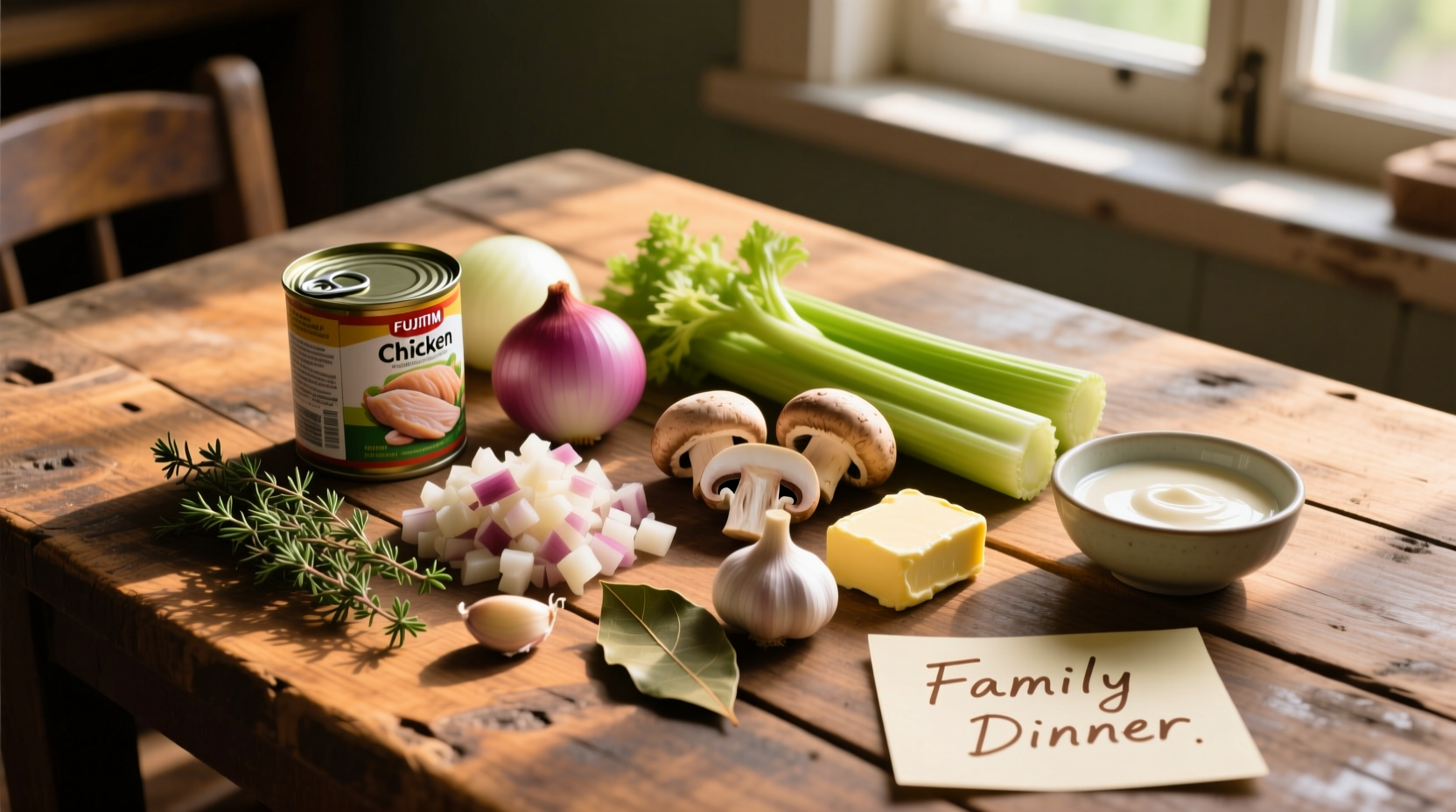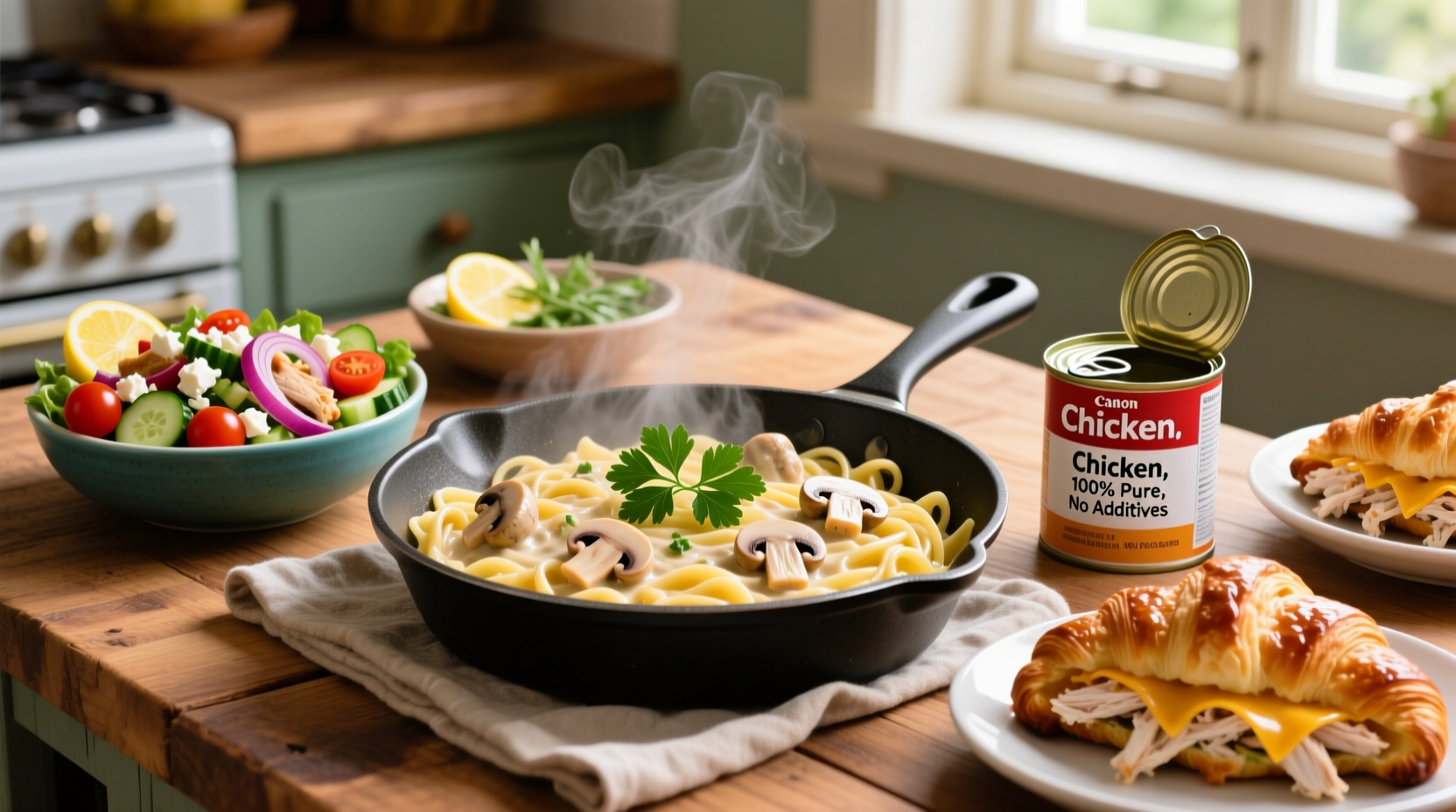Why Canned Chicken Deserves a Second Look
Many home cooks dismiss canned chicken as inferior, but when used properly, it's a versatile pantry hero. According to USDA nutritional data, a 3-ounce serving of canned chicken provides 13g of protein with comparable nutritional value to fresh cooked chicken breast. The key difference? Canned chicken saves an average of 45 minutes of preparation time compared to cooking fresh chicken—a critical advantage for busy weeknights.
| Nutrient | Canned Chicken (3oz) | Fresh Chicken Breast (3oz) |
|---|---|---|
| Protein | 13g | 14g |
| Calories | 60 | 94 |
| Sodium | 280mg | 50mg |
| Prep Time | 5 minutes | 50 minutes |
While sodium content is higher in canned varieties, rinsing thoroughly reduces sodium by up to 30% without compromising texture. The FDA confirms canned chicken maintains safety for up to 3-5 years when stored properly in a cool, dry place—making it an excellent emergency pantry item.
Professional Texture Transformation Techniques
Texture issues plague many canned chicken attempts. Professional chefs use these three methods to achieve restaurant-quality results:
- Dry brine with cornstarch: Toss drained chicken with 1 teaspoon cornstarch per cup of chicken, then let sit 10 minutes before cooking. This absorbs excess moisture while creating a light crust when sautéed.
- Acid activation: A splash of lemon juice or vinegar (1 tsp per cup) brightens flavor and breaks down any rubbery texture within 5 minutes.
- Layered seasoning: Add 1/4 teaspoon garlic powder and onion powder during cooking, then finish with fresh herbs off-heat to prevent bitterness.

5-Minute Emergency Meals (When Time Is Critical)
These solutions require only canned chicken and 2-3 pantry staples. Perfect for those "I have nothing to cook" moments:
- Instant Chicken Salad: Mix 1 cup chicken with 2 tbsp mayo, 1 tsp mustard, and chopped celery. Serve in lettuce cups or with crackers.
- Speedy Quesadilla: Spread chicken between tortillas with shredded cheese. Cook 3 minutes per side in a dry skillet.
- Pantry Pasta: Toss drained pasta with chicken, olive oil, garlic powder, and red pepper flakes.
Weeknight Dinner Heroes (15-30 Minute Meals)
These globally-inspired recipes transform canned chicken into impressive dinners:
Mediterranean Chicken Pasta
Combine 2 cups cooked pasta with 1 cup chicken, 1/2 cup artichoke hearts, 1/4 cup sun-dried tomatoes, and 3 tbsp pesto. Top with feta cheese and fresh basil. Ready in 20 minutes.
Asian Ginger-Sesame Stir Fry
Sauté chicken with 1 tbsp sesame oil, 1 tsp grated ginger, and 2 minced garlic cloves for 3 minutes. Add frozen vegetables and 2 tbsp soy sauce. Serve over instant rice. Total time: 15 minutes.
Southwest Chicken Soup
Simmer 1 can chicken broth, 1 cup chicken, 1/2 cup black beans, 1/2 cup corn, and 1 diced tomato for 10 minutes. Stir in 1 tsp cumin and 1/4 tsp chili powder. Top with avocado.
Meal Prep Mastery
Canned chicken shines in meal prep. Portion into containers with different sauce bases:
- Creamy base: Greek yogurt + lemon juice + dill (for salads)
- Tomato base: Marinara + Italian herbs (for pasta)
- Broth base: Low-sodium broth + ginger (for soups)
Store components separately and combine when ready to eat. Properly stored, these components last 4 days in the refrigerator according to FDA food safety guidelines.
Avoid These Common Mistakes
Even experienced cooks make these canned chicken errors:
- Skipping the drain: Excess liquid dilutes flavors. Always drain and press gently with paper towels.
- Overheating: Canned chicken only needs warming through—excessive cooking makes it tough.
- Underseasoning: Canned chicken requires 25% more seasoning than fresh due to liquid absorption.
- Ignoring texture: Without proper treatment (like the cornstarch method), texture suffers.
FAQ: Your Canned Chicken Questions Answered
Can I use canned chicken in place of cooked chicken in recipes?
Yes, with adjustments. Use 1.5 cups drained canned chicken for every 1 cup cooked fresh chicken. Reduce added liquids by 2-3 tablespoons since canned chicken contains moisture. For best results, apply the cornstarch dry-brine technique before adding to recipes.
How do I make canned chicken taste less processed?
Boost flavor with acid (lemon juice or vinegar), fresh herbs added at the end, and proper seasoning layers. Sautéing with aromatics like garlic and onions for 2-3 minutes creates complex flavors that mask any processed taste. The University of California Food Science Department confirms acid activation significantly improves perceived freshness.
Is canned chicken as healthy as fresh chicken?
Nutritionally comparable in protein content, but higher in sodium. Rinsing reduces sodium by 30%. Choose low-sodium varieties when available. The USDA confirms canned chicken maintains similar protein quality to fresh, making it a valid healthy option when prepared properly.
What's the best way to store leftover canned chicken?
Transfer to an airtight container with any remaining liquid from the can. Refrigerate for up to 4 days. For longer storage, freeze in portion-sized containers for up to 3 months. The FDA recommends labeling with dates and using within these timeframes for optimal safety and quality.











 浙公网安备
33010002000092号
浙公网安备
33010002000092号 浙B2-20120091-4
浙B2-20120091-4